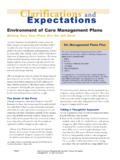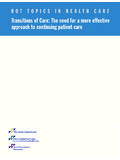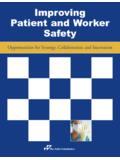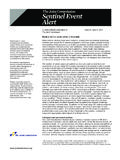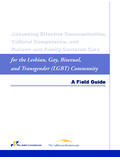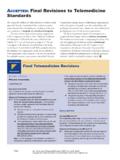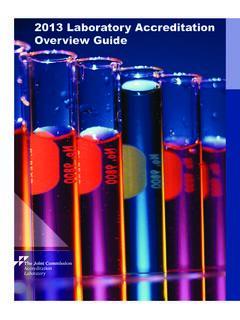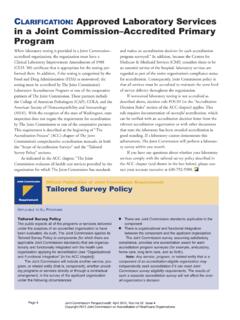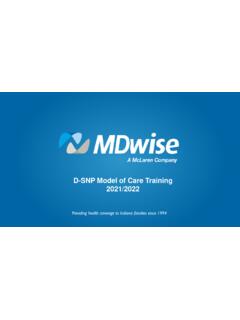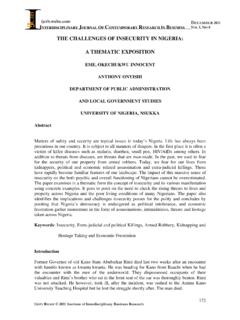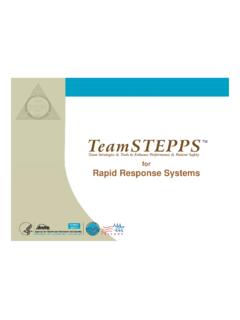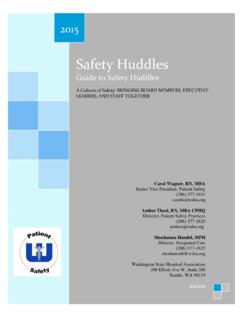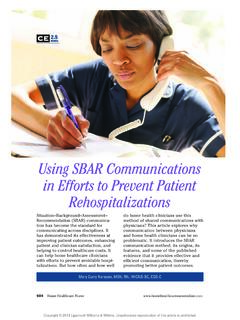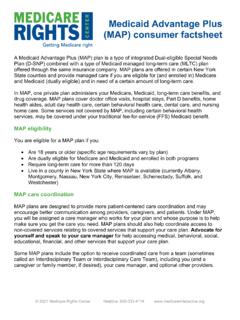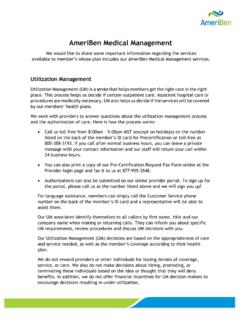Transcription of Patient Safety Systems (PS) - Joint Commission
1 Patient Safety Systems (PS). Introduction The quality of care and the Safety of patients are core values of The Joint Commission accreditation process. This is a commitment The Joint Commission has made to patients, families, health care practitioners, staff, and health care organization leaders. This chapter exemplifies that commitment. The intent of this Patient Safety Systems (PS) chapter is to provide health care organizations with a proactive approach to designing or redesigning a Patient -centered system that aims to improve quality of care and Patient Safety , an approach that aligns with the Joint Commission 's mission and its standards.
2 The Joint Commission partners with accredited health care organizations to improve health care Systems to protect patients. The first obligation of health care is to do no harm. Therefore, this chapter is focused on the following three guiding principles: 1. Aligning existing Joint Commission standards with daily work in order to engage patients and staff throughout the health care system, at all times, on reducing harm. 2. Assisting health care organizations with advancing knowledge, skills, and com- petence of staff and patients by recommending methods that will improve quality and Safety processes.
3 3. Encouraging and recommending proactive quality and Patient Safety methods that will increase accountability, trust, and knowledge while reducing the impact of fear and blame. Quality* and Safety are inextricably linked. Quality in health care is the degree to which its processes and results meet or exceed the needs and desires of the people it ,2. Those needs and desires include Safety . The components of a quality management system should include the following: n Ensuring reliable processes *. The Institute of Medicine defines quality as the degree to which health services for individuals and populations increase the likelihood of desired health outcomes and are consistent with current professional knowledge.
4 Source: Committee to Design a Strategy for Quality Review and Assurance in Medicare, Institute of Medicine. Medicare: A Strategy for Quality Assurance, vol. 1. Lohr KN, editor. Washington, DC: The National Academies Press, 1990. CAMH, January 2021 PS 1. Comprehensive Accreditation Manual for Hospitals n Decreasing variation and defects (waste). n Focusing on achieving positive measurable outcomes n Using evidence to ensure that a service is satisfactory Patient Safety emerges as a central aim of quality. Patient Safety , as defined by the World Health Organization, is the prevention of errors and adverse effects to patients that are associated with health care.
5 Safety is what patients, families, staff, and the public expect from Joint Commission accredited organizations. While Patient Safety events may not be completely eliminated, harm to patients can be reduced, and the goal is always zero harm. This chapter describes and provides approaches and methods that may be adapted by a health care organization that aims to increase the reliability of its complex Systems while making visible and removing the risk of Patient harm. Joint Commission . accredited organizations should be continually focused on eliminating Systems failures and human errors that may cause harm to patients, families, and ,2.
6 The ultimate purpose of The Joint Commission 's accreditation process is to enhance quality of care and Patient Safety . Each requirement or standard, the survey process, the Sentinel Event Policy, and other Joint Commission initiatives are designed to help organizations reduce variation, reduce risk, and improve quality. Hospitals should have an integrated approach to Patient Safety so that high levels of safe Patient care can be provided for every Patient in every care setting and service. Hospitals are complex environments that depend on strong leadership to support an integrated Patient Safety system that includes the following.
7 N Safety culture n Validated methods to improve processes and Systems n Standardized ways for interdisciplinary teams to communicate and collaborate n Safely integrated technologies In an integrated Patient Safety system, staff and leaders work together to eliminate complacency, promote collective mindfulness, treat each other with respect and compassion, and learn from their Patient Safety events, including close calls and other system failures that have not yet led to Patient harm. What Does This Chapter Contain? The Patient Safety Systems (PS) chapter is intended to help inform and educate hospitals about the importance and structure of an integrated Patient Safety system.
8 This chapter describes how existing requirements can be applied to achieve improved Patient PS 2 CAMH, January 2021. Patient Safety Systems . Safety ; it does not contain any new requirements. It is also intended to help all health care workers understand the relationship between Joint Commission accreditation and Patient Safety . This chapter does the following: n Describes an integrated Patient Safety system n Discusses how hospitals can develop into learning organizations n Explains how hospitals can continually evaluate the status and progress of their Patient Safety Systems n Describes how hospitals can work to prevent or respond to Patient Safety events (Sidebar 1, below, defines key terminology).
9 N Serves as a framework to guide hospital leaders as they work to improve Patient Safety in their hospitals n Contains a list of standards and requirements related to Patient Safety Systems (which will be scored as usual in their original chapters). n Contains references that were used in the development of this chapter This chapter refers to a number of Joint Commission standards. Standards cited in this chapter are formatted with the standard number in boldface type (for example, Standard ) and are accompanied by language that summarizes the standard. For the full text of a standard and its element(s) of performance (EP), please see the Appendix.
10 Sidebar 1. Key Terms to Understand n Patient Safety event: An event, incident, or condition that could have resulted or did result in harm to a Patient . n Adverse event: A Patient Safety event that resulted in harm to a Patient . n Sentinel event: A subcategory of adverse events, a sentinel event is a Patient Safety event (not primarily related to the natural course of the Patient 's illness or underlying condition) that reaches a Patient and results in any of the following: o Death o Permanent harm continued on next page . For a list of specific Patient Safety events that are also considered sentinel events, see page SE-1 in the Sentinel Events (SE) chapter of this manual.


